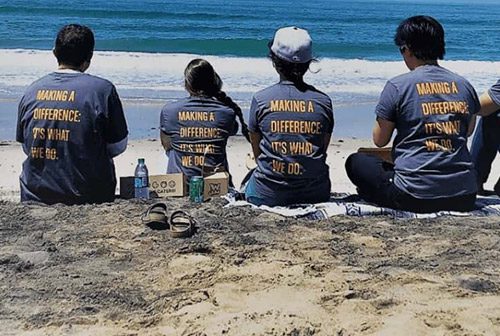Last week, I attended National Geographic’s Marine Recreation Workshop at Scripps Seaside Forum. The workshop brought together some of Southern California’s top business owners, professionals and employees in the marine recreation community. People traveled from as far as Santa Barbara to listen to presentations on current ocean issues. Presenters included experts from Birch Aquarium, Scripps Institution of Oceanography, I Love A Clean San Diego, the Pacific Marine Mammal Center, the Pfleger Institute of Environmental Research and our very own Alicia Glassco of San Diego Coastkeeper. At the end of the event, National Geographic announced a grant program for any business or organization having to do with the ocean, intended for projects relating to some of the topics discussed at the event (for more information on the grant program, contact me). Here are highlights from the presentation.
- Water Quality – Issues and Causes: Inland actions are directly related to our ocean through watersheds. These watersheds carry pollution such as yard clippings, pet waste, fertilizers and pesticides, chemicals, trash and motor oil. Prevention of our ocean happens inland. Click here to learn about ways you can help minimize pollution and join us in testing the water in our watersheds.
- Marine Debris: Impacts, Removal and Prevention: Alicia talked about the debris found in our oceans, with an emphasis on harmful plastic waste. These plastics are often mistaken for food by animals, leaving them to suffocate, starve and die. The Pacific Gyre, sometimes incorrectly referred to as the “Garbage Patch,” is a soup-like current system in the Pacific Ocean consisting of tiny bits of photodegraded plastic. We can prevent plastic and other debris from entering our ocean by refusing to use plastic foam products or take-out containers, encouraging businesses to use alternative materials or asking for foil or bringing tupperware for to-go foods.
- The Science Behind Marine Protected Areas: Marine protected areas (MPAs) succeed all over the world, like in Cabo Pulmo, Mexico. There, fish are bigger, they are having more offspring, ecosystems are thriving and fishermen are reaping the benefits due to the “spillover effect.” All-in-all, MPAs are easy ways to keep the ocean healthy, especially when the community is on board to ensure their success.
- Biology, ecology and movement patters of pelagic sharks of the Southern California Bight: What is a pelagic shark? It refers to a shark that lives in open water, rather than near to shore. What is the Southern California Bight? This is the large circular current system stretching from Baja to the Channel Islands and Santa Barbara. Blue sharks, white sharks, mako sharks and thresher sharks are common in this area, because the bight serves as a rookery or nursery for all these species.
- Marine Mammals: This presentation focused mainly on two kinds of pinnipeds or marine mammals with short, flat and wide flippers – seals and sea lions. Seals are small, football shaped, propel themselves on dry land by doing what looks like “the worm” and they have no external ear flaps. Sea lions are larger, propel themselves on land by using their back flippers as a sort of third foot and have external ear flaps. These animals are often on our beaches; this does not mean they are stranded. A standed seal or sea lion looks dehydrated, has dry eyes, has excessive wrinkles and you can see their hip bones. When you see a distressed animal, call a rescue team or alert a lifeguard to do so.
- The Ecology and Conservation of Giant Kelp Forest Communities: Did you know that the kelp forest in La Jolla grows the size of one adult blue whale per day?! Kelp grows so fast that it replenishes itself once every six months. Kelp forests serve as vital ecosystems for a variety of marine life, but it is negatively impacted by overfishing. This is because top predators, like lobsters and sheephead, are overfished, leaving no predator of sea urchins behind. Sea urchins eat kelp and can kill off entire forests, causing what are called “urchin barrens.” This is why one of the benefits of MPAs is healthy kelp forests, leading to healthy ecosystems.
- Communicating Ocean Conservation: making our messages meaningful: In delivering these important messages to clients, visitors or community members, know your audience. Knowing their values will help you design a message that is meaningful to them. Using simple models and analogies helps people understand issues in real, understandable terms (for example, “La Jolla kelp grows the size of a blue whale per day”).













